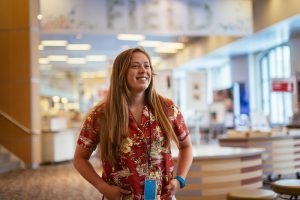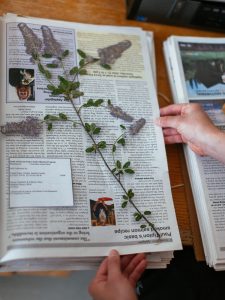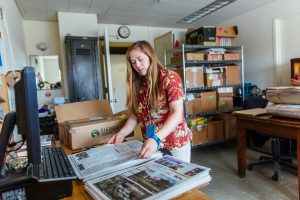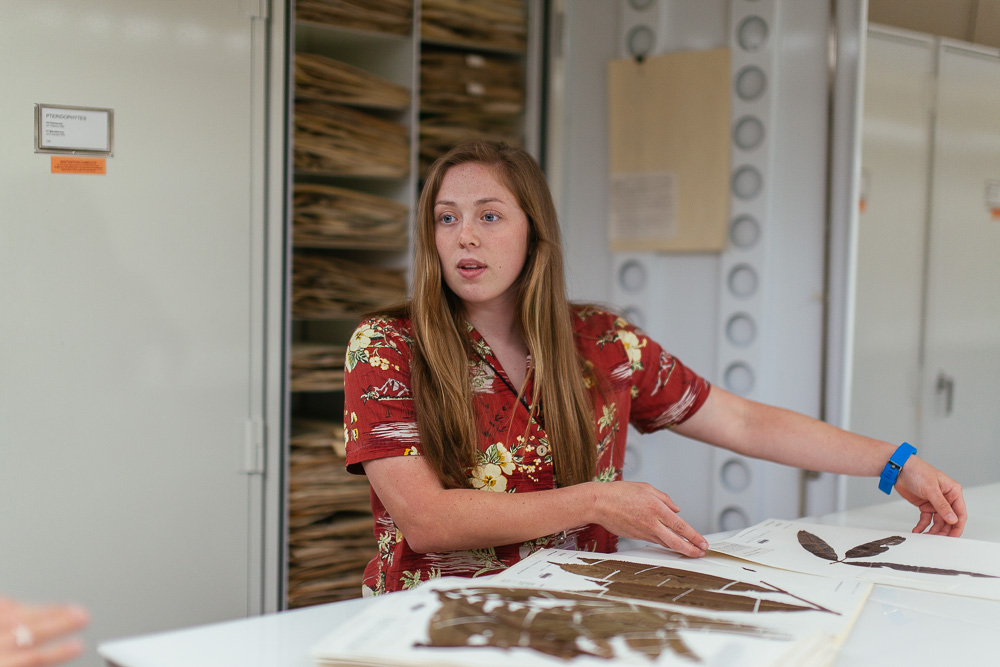Eastern Mennonite University student Amanda Williams has spent her spring semester supporting the “modest” effort of the Smithsonian Institute Museum of Natural History to catalog its collection of 4.5 million botanical specimens. Not a bad gig for a junior “enthralled with the natural world” who is double majoring in biology and environmental sustainability.

Williams, a junior from Millsboro, Delaware, was a participant this semester with the Washington Community Scholars’ Center, a program that combines a semester in the nation’s capital, living with other students in a house in the Brookland area and working four days a week in an internship.
William’s internship role is akin to a circulation librarian. Rather than books, however, she deals with plant specimens. She helps send, receive and catalog specimens for the Botany Collections Management Department
On a typical day at the facility on 10th and Constitution Avenue near the Mall, Williams receives four or five boxes, each with 10 to 200 botanical samples —usually leaf, stem and flower. She mails out a similar quantity of specimens to researchers worldwide, who use them to puzzle out, for example, genetic evolution, biodiversity loss, and climate change.
She opens a box to find specimens pressed and mounted on archival paper or placed within sheets of newsprint. She records the basic transactional data. Then, if a specimen is to be filed in the museum’s collection, rather than passed along to an individual researcher, she’ll enter it into the database: scientific name; identifying number unique to the museum; collector’s name; and date and location from which it was gathered, including such specifics as altitude and GPS coordinate.
She also catalogs this data for specimens already in the herbarium’s holdings, some of which were gathered up to 150 years ago.

Williams enjoys the work: “I find it very interesting to see plants from all over the world and learn about their taxonomic rank and geographic distribution.”
She also assists with, and is a fan of, the Seeds of Success Program, a collection of native plant seeds sent from herbaria around the country. When these come to her, she ensures they’re labeled and forwards them to a Smithsonian support center where they’re deposited in a germplasm repository, an effort to thwart species extinction and restore sustainable ecosystems.
Grounding herself in Earth’s plant kingdom is a step toward Williams’s “ultimate dream”of conducting research on the International Space Station. “My mom says I talked about being an astronaut since I first learned to speak,” she recalled. As a child, she stargazed through her own telescope, scrutinized photos of outer space in books and was hooked on Star Trek.
Her interest in nature bloomed in her first biology class—with teacher Darryl Hudson at Delmarva Christian High School in Georgetown, Delaware—where the intricate yet efficient workings of plant and animal cells awed her. “My appreciation of both nature and God grew,” Williams said. Later, when she learned how research in space is opening frontiers into understanding biological systems, her two interests coalesced into a career plan.
A major benefit of her semester in D.C. is a free ticket to visit other Smithsonian museums and to attend their seminars. She joined a group of middle-schoolers participating in a Youth Astronomers summit at the National Air and Space Museum to learn how to remote-control a sophisticated orbiting telescope to obtain space images of their choice. Amanda took and edited photos of the Eagle Nebula and Andromeda Galaxy.
“Washington is a really cool place to be,” she said.” I went to the Inauguration and Women’s March, both historical events I won’t forget.”
Williams has also taken in cultural fare, including a current exhibit “people are going crazy over” at the Hirshhorn Museum—the hallucinatory “Infinity Mirror Rooms” of Yayoi Kusama. “I use my badge to jump in line,” she says with a laugh.

Williams lives with 13 other students in the Nelson Good House, where doing chores together creates “bonding time” and “there’s always someone to hang out with.”
Her unique contribution: sharing an enthusiasm for guppies. “While here, my guppies—a brilliant aquamarine-blue male and a red and blue female with a black-spotted tail—have had 30-plus babies, and more are on the way. It’s so cool to see people from my house interested in them because many have never had experience with breeding fish.”
At semester’s end, she’ll gift one of these tropical Poecilia reticulata to any housemate she’s sure will properly care for it. Then, she heads back to EMU, where she’s been awarded, with Hannah Daley, EMU’s first summer student research grant. The duo will explore the relationship between canopy cover and stream water temperature in two headwater streams near Bergton, Va.
Editor’s note: WCSC regularly places students at Smithsonian sites, including the Anacostia Community Museum, the National Portrait Gallery, Natural History Museum, American History Museum, Office of the Chief Information Officer (OCIO), Office of Exhibits Central, Center for Folklife and Cultural Heritage.
